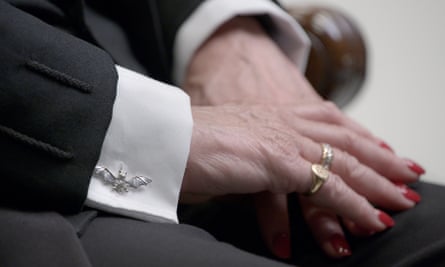Carey Young: Appearance review – the faces of female justice
Modern Art Oxford The British artist’s enduring fascination with justice and the law has yielded an outstanding new film in a riveting retrospective

Article from The Observer - read the full article here:
Vivien Rose, supreme court justice, stares steadily back at you from Carey Young’s outstanding new film at Modern Art Oxford. Lady Rose is only required to sit for two minutes in this red leather chair but the pressure of time (and the lens) is upon her. The imperturbable gaze flickers ever so slightly, as she waits for the endless moment to pass. Why is she still here, when she could be dispensing justice?
Appearance – the film’s title plays on the way we come before her and she before us – takes off from Andy Warhol’s celebrated 1960s Screen Tests. But Young is British and born in 1970. Instead of Bob Dylan or Lou Reed, she invites a succession of our female judges into her spotlit studio. You see them arrive, take their seat and try to keep entirely still. Each appearance quickens into psychological drama.
A solemn young woman, with matching lips and nails, looks at the camera with something approaching hostility. A middle-aged judge, wig removed, reveals the carefully brushed tips of her blue-dyed hair even as she conceals her hands beneath kid gloves arranged across her lap. There are abruptly crossed legs, restless fingers and even a hint of growing warmth from a diminutive lawyer whose feet barely touch the ground even in towering stilettos. She stops just short of a full-blown smile.
Is it the occasion or the profession that controls the pose? What should a female judge look like? I came into the gallery just as a woman of exceptional youth and beauty was arriving on screen and the viewer next to me gasped. The artist – her camera noticing emerald rings, expensive hair, judicious eyeliner – mocks our preconceptions. Judge not lest ye be judged.

A still from Appearance (2023). Photograph: © Carey Young. Courtesy the artist and Paula Cooper Gallery, New York
Young’s profound and involving examination of the law has continued through film, photography and installation art for more than 20 years. This retrospective presents some of her most acute works. Counter Offer, from 2008, consists of two framed propositions. “Offer – I offer you liberty” (though the fine print below warns that this offer will be automatically withdrawn on the making of any counteroffer, which is hereby rejected) and “Counter Offer – I offer you justice”. The elements are mutually exclusive, freedom and justice incompatible, or so runs this dark double bind.
Obsidian Contract (2010) consists of a legal document written backwards that only becomes legible when you peer into its reflection in a black mirror. Whereupon it turns – according to the written claim – into a contract whereby you agree that the mirror is now a piece of common land. All sorts of banned activities, from nudism to loitering to public protest, are magically legal in this illusory place. Look away, though, and your freedom has all gone.
Two recent prints seem to show an expanse of twinkling stars in a night sky and, by contrast, dark flecks in a stretch of white ice. The first is in fact a photograph of a notice board in a law school, the documents removed to reveal the pinpricks; the second, the wall of a prison yard. One is the complex reverse of the other, or so you might say, in life as here now in art.
Each appearance is a discrete essay in character, from the serenely confident to the impassive, impervious or resistant
A recent self-portrait, if that isn’t an overstatement, shows a faint reflection of the artist in a group photograph of US supreme court judges. You can scarcely see Young, who has a camera to her eye in any case, but nor can you quite make out the only woman in the shot. This is Sandra Day O’Connor, the first American woman to hold that office, surrounded by men and obscured by a flash of light.

‘Eye to startled eye’: a still from Carey Young’s Palais de Justice (2017). Photograph: © Carey Young. Courtesy the artist and Paula Cooper Gallery, New York
Young’s acclaimed 2017 film Palais de Justice moves as if by stealth through the soaring architecture of the Brussels law courts, noticing strange symmetries, hidden figures, the weird murmur of voices that are always elsewhere, behind closed doors. Her camera peers through the curious porthole windows set into those doors, watching women judges listening, arguing, shifting with impatience (in one case turning straight towards us, eye to startled eye).
What does the law look like? With subtle editing, it is suddenly made to look (like the figure of Justice herself) entirely and unprecedentedly female.
Yet the art in this show is always and aptly interrogative. What difference would it make if there were more women judges? (Rose is at present the only female justice out of 12 in the UK supreme court.) Appearance presents numerous British women on screen from various backgrounds and levels – junior and venerable, black, white and Asian, dressed in starched linen, white ermine and even the gold-encrusted robes of the highest courts in the land that require a flunky to trail behind lifting the hem.
Each appearance is a discrete essay in character, from the serenely confident to the impassive, impervious or resistant. But what Young’s camera notices, too, is the luxurious jewellery, the costly makeup, shoes and hair; the extraordinary fact of the soft hands and the unlined faces – scarcely a frown mark, despite the burdens of office. It is as if the law has imposed its own style upon these women, as much as any men, keeping them all in line.
-
Carey Young: Appearance is at Modern Art Oxford until 2 July


